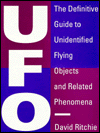UFO: The Definitive Guide to Unidentified Flying Objects and Related Phenomena
David Ritchie
 This book brings readers up to date on some of the most recent reports, research and speculation concerning UFOs, including alleged physical evidence of spacecraft and incidents of apparently hostile activity by UFOs, notably in Latin America. There are descriptions of many scientific research projects on the subject and ample coverage of the UFO as a psychological and spiritual phenomenon. Numerous investigations and theories surrounding the UFO controversy are included in this volume, and famous UFO hoaxes are exposed. This book brings readers up to date on some of the most recent reports, research and speculation concerning UFOs, including alleged physical evidence of spacecraft and incidents of apparently hostile activity by UFOs, notably in Latin America. There are descriptions of many scientific research projects on the subject and ample coverage of the UFO as a psychological and spiritual phenomenon. Numerous investigations and theories surrounding the UFO controversy are included in this volume, and famous UFO hoaxes are exposed.
|
choose one of the following:
Further
information, reviews, & details
From the Publisher
This book brings readers up to date on some of the most recent reports, research and speculation concerning UFOs, including alleged physical evidence of spacecraft and incidents of apparently hostile activity by UFOs, notably in Latin America. There are descriptions of many scientific research projects on the subject and ample coverage of the UFO as a psychological and spiritual phenomenon. Numerous investigations and theories surrounding the UFO controversy are included in this volume, and famous UFO hoaxes are exposed. The book examines some of the connections between New Age religious phenomena and UFO investigations, such as the former Soviet technique of using "biolocation," a "psychic" procedure comparable to dowsing, to identify alleged landing sites of UFOs.
From The Critics
Library Journal
Although this book may not be definitive, as its subtitle claims, its emphasis on the paranormal aspects of UFOs does make it unique. Ritchie admits his bias toward the paranormal explanation, arguing that it is more consistent with the reports of sightings, abductions, and related phenomena. For the most part, Ritchie has opted for artists' conceptions rather than photographs since, he believes, no convincing UFO photos have ever been taken. There are two to three entries per page covering people, places, events, science fiction films, and topics like belief systems, New Age Movement, and religion. Extensive cross references help users track down entries. Also included is a highly selective bibliography of books published in the 1980s and 1990s. This work will help anyone from high school on up explore this ever-fascinating mystery. John Spencer's UFO Encyclopedia (Avon, 1993), a similar A-Z guide with a British slant, can serve as a complementary resource. Highly recommended.-Gary D. Barber, SUNY at Fredonia Lib.
BookList
In the preface to this guide to UFO phenomena, Ritchie rejects the view that extraterrestrials are visiting earth. Knowledge of surrounding planets indicates none can support life even remotely similar to Earth, the distances to other solar systems are too vast for visitors, and no solid evidence has ever been discovered to support the existence of life beyond Earth. He does believe UFOs are real but relies on paranormal or spiritual explanations. He cites the similarities between accounts of UFO pilots with demonic visitations Arranged in alphabetical order by subject, the entries include accounts of UFO sightings, both unexplained and hoaxes. Also included are other phenomena such as the appearance of the Virgin Mary at Fatima and accounts of encounters with demons by early church writers. Ritchie also discounts the theories of Erich Van Daniken, who postulated that the ancient "gods" were actually space travelers. Ritchie thinks the Nazca lines in Peru, which can be seen only from the air, were drawn by primitives using hot air balloons. He does not give a reference for this bit of information. He also covers "crop circles," which have puzzled Europeans for decades, but does not mention the two elderly men who claimed responsibility for those in England. A selected bibliography with 36 titles is included at the end of this work. More than 50 black-and-white illustrations are included. Although most articles include cross-references to related topics, there is an index as well Jerome Clark's three-volume UFO Encyclopedia series (Omnigraphics, 1990-93) covers the earliest sightings to the present. The articles are longer, and sources are cited at the end of most entries. Clark avoids the easy answers, while not ruling out any possibility, including extraterrestrials. Ritchie's work is an interesting interpretation of some very puzzling phenomena, but it is not up to the quality of Clark. "UFO" is not a necessary purchase for libraries already holding Clark's encyclopedia, but libraries where demand is high for information on UFOs, the paranormal, and New Age or spiritual information may want a copy for the circulating collection.
|
